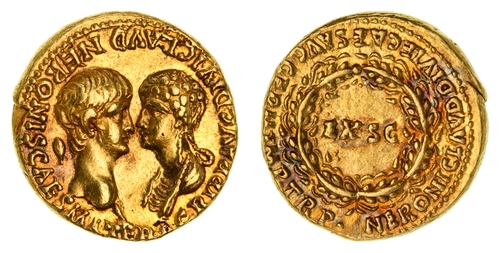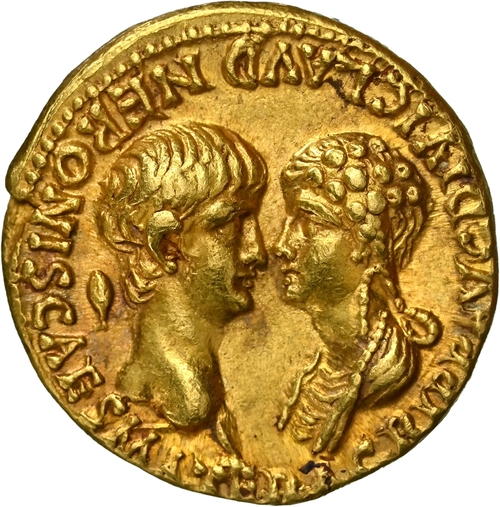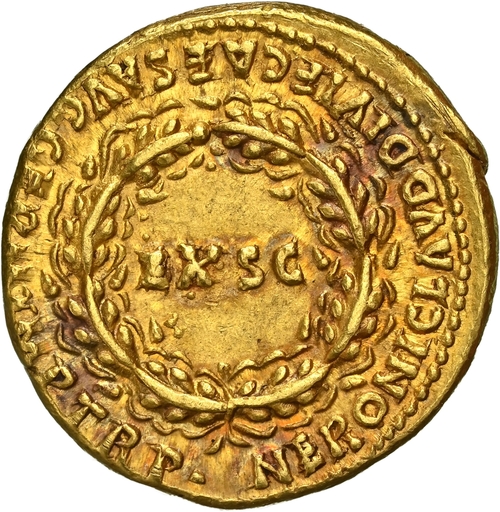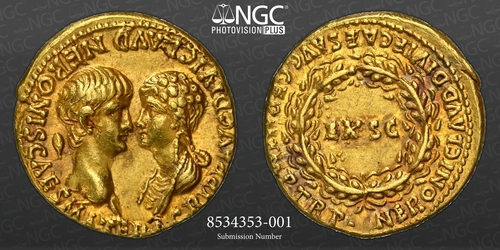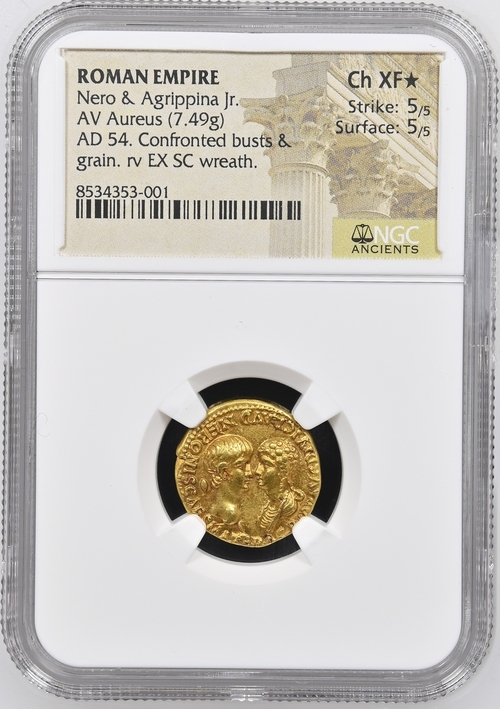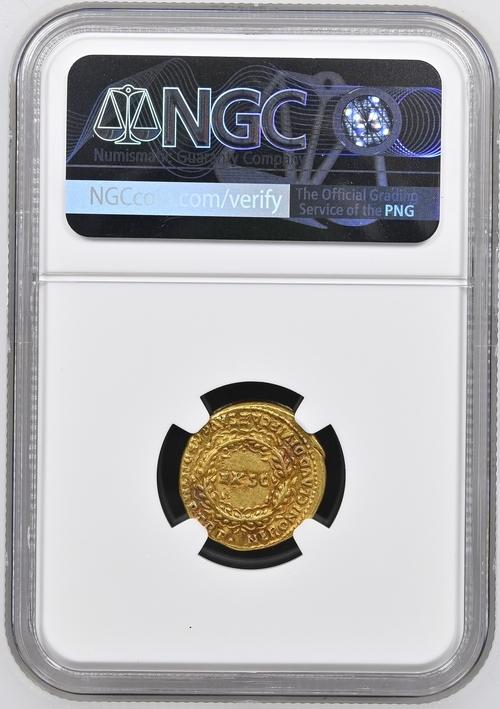Auction: 25055 - British Medals and World Coins featuring The Hurter-Amman Collection of Ancient and European Gold
Lot: 1092
NGC Choice XF STAR | Roman Empire, Nero, with Agrippina Junior (54-68), Commemorative 'Praetorian Guard' AV Aureus, struck 4-31 December AD 54, Rome, to commemorate the Imperial Accession Grain Ration Bonus, AGRIPP AVG DIVI CLAVD NERONIS CAES MATER, bare-headed and undraped bust of Nero (right), a corn grain behind his head, confronting draped and plaited bust of Agrippina (left), rev. NERONI CLAVD DIVI F CAES AVG GERM IMP TR P, oak wreath enclosing EX SC, 7.49g, 12h ([a] Borghesi 1544 = Montagu 153 = Yates-Thompson = Ryan 1652 = Biaggi 219 = Steinberg 235 = NAC 138 [18 May 2023], 648; [b] Vaudecrane 8 = "Money of the World", no. 38 = "Millenia" 88 = Maison Palombo 17 [20 October 2018], 47 [140,000 CHF]; [c] BMC 2 these dies; Calicó 400 this obverse die; RIC I, 3 [R4]), lustrous, an exceptional example of this great rarity, very attractive extremely fine, in NGC 'Ancients' holder, graded Choice XF* (Cert. #8534353-001) [Strike: 5/5, Surface: 5/5]
Provenance
The "Hurter-Amman" Collection of Ancient and World Gold and Silver Coins and Medals
Hans Nussbaum (1902-1939), by private treaty, Zurich, c. 1938 - CHF 400
Almost certainly:
Boscoreale Hoard, dispersed 1894
This excessively rare aureus is dated to the first weeks of Nero's reign, which began with his dies imperii, on the 13 October AD 54, quickly following Claudius' death the preceding day. Subsequently, Nero was conferred with tribunicia potestas on the 4 December AD 54 but did not begin his first consulship until the 1 January AD 55. Therefore, IMP TR P, the final honorifics of the reverse legend, place the striking of this coin, or at least the decision to strike it, in the final twenty-seven days of the year AD 54. Besides the precision of its dating, it is the inclusion of a small corn-grain (or possibly laurel leaf) in the obverse left field which makes this coin a great rarity. Perhaps only a handful of dies and seven specimens are known. Indeed, this represents the first to appear in these rooms for over thirty years.
The exact purpose of this symbol is unknown. Some have described it as a laurel leaf and linked it to the funerary games of Claudius, though this is difficult to believe when taken alongside the assertion of ancient historians that Agrippina poisoned him. An alternative suggestion is that it is in some way linked to the largess displayed by Nero in his first days of power as he tried to buy support. Tacitus records that, following the example of his father Claudius, Nero promised a donative to the Praetorian Guard (Tac. Ann. XII.69). While Suetonius tells us that after giving money to senators, to the praetorians he granted a monthly grain allowance, frumentum menstruum gratuitum (Suet. Nero 10). It is tempting, then, to suggest that this rare issue was marked either to pay for the grain, or to be given alongside it.
The confronted busts of Nero and Agrippina are also of historical interest. Agrippina's prominent position was not new. During the reign of Claudius, she was the first to be depicted as an empress on coinage within her lifetime. By marrying Claudius, Agrippina provided an important dynastic link to her great-grandfather Augustus and united the Julian and Claudian lines. This also allowed for the adoption of Nero, born Lucius Domitius Ahenobarbus (Red-beard), as imperial heir.
This dynastic importance is shown in the obverse legend, AGRIPP AVG DIVI CLAVD NERONIS CAES MATER, which reads Agrippina Augusta, (wife of) Divine Claudius, mother of Nero Caesar. The dedication of the obverse legend to Agrippina, instead of Nero, shows her political dominance over the emperor. Indeed, Suetonius writes that on the first day of Nero's rule he handed over the sum total of all public and private affairs to his mother, matri summam onmium rerum priuatarum publicarumque permisit (Suet. Nero 9).
Despite calling her the best of mothers, optimam matrem (Suet. Nero 9), the (perhaps rather too) close relationship between Nero and his mother would be short-lived. From AD 55, the statesman Seneca and Praetorian prefect Afranius Burrus replaced Agrippina as quasi-regents, giving rise to a very iconographically uniform series of 'senatorial types' (cf. EX Senatus Consulto on lot 1093) that preceded Nero's unfettered despotism and the more personal post-reform types which accompanied it.
Agrippina's overbearing scrutiny soon became too much and after a series of bizarre assassination attempts, involving failed contraptions such as trick falling ceiling panels and a collapsible boat, Nero had her stabbed in AD 59. Suetonius records a common joke about the event: "Who can say that Aeneas' great family tree doesn't include Nero? One carried out his father, the other carried off his mother!" (Suet. Nero 39)
https://www.ngccoin.uk/certlookup/8534353-001/NGCAncients/
Subject to 20% VAT on Buyer’s Premium. For more information please view Terms and Conditions for Buyers.
Sold for
£110,000
Starting price
£25000

